The success of plastic surgery, as you know, depends on many factors. Without a doubt, the skill of the surgeon is the main one. However, as experience shows, even an impeccable operation does not guarantee excellent results without proper resource support of the skin in the pre- and postoperative period. Therefore, Elena Stoyanova presented a new drug Profhilo, which has proven itself in practical work with patients both at the stage of preparation for surgery and in the postoperative period.
Elena Stoyanova PhD
Head of estet-portal
As you know, the success of plastic surgery depends on many factors. In the first place we put the skill and ability of the surgeon, which is undeniable. However, experience shows that the results of even the most brilliantly performed operation can be compromised due to insufficient attention to the resource support of the skin in the pre- and post-operative period.
In the process of any operation, the area of intervention, as well as the body as a whole, is subjected to stress. Due to the intersection of many vessels, the blood supply in the operation area changes significantly. And although new ones open to replace the crossed capillaries, their permeability increases, edema appears and inflammation develops. Due to the breakdown of hemoglobin, the skin at the site of the injury changes its color, and long-term hematomas appear.
We know that, in addition to impaired venous outflow, which is the main cause of edema, there is always a partial lymphatic blockade. The degree of development of edema and the duration of their delay on the face depend not only on the severity of the subcutaneous fat layer, but also on the extent of the zone of detachment of the skin flaps. And on how correctly it will be to "go" swelling, depends on the condition of the sutures.
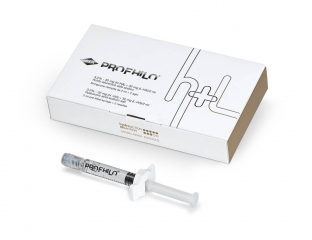
Adequate innervation of damaged tissues is also disrupted, the intensity of metabolic processes in the skin decreases, as a result of which the rehabilitation period is delayed.
The skin that has been treated with antiseptic preparations more than once dries out. Here are just a few of the complex processes that occur in tissues in response to mechanical damage.
How stress during plastic surgery affects the skin
When we talk about skin stress, we mean not only a psycho-emotional state that leads to a dermatological disease, but also “postoperative stress”, which can not only worsen the condition of healthy skin, but also exacerbate chronic dermatological diseases, which are often in in remission or not yet manifested.
There are much fewer problems and complications, including psycho-emotional ones, in those patients for whom the intervention of a plastic surgeon is of a reconstructive nature and is due to physiological necessity. These patients are always satisfied with the result of the operation.
As for patients for whom plastic surgery is a way to create a new, improved image, their patients' expectations for surgery will always be unreasonably high. These are usually neurotic patients (constituting 43%) who will develop dermatological diseases.
And in case of such skin diseases as neurodermatitis, urticaria, atopic dermatitis, itching, alopecia, etc. stress is a trigger in 85% of cases.
What exactly happens in the skin under stress
In his work, PM Elias demonstrated that against the background of local stress, the permeability of the skin barrier changes, i.e. the barrier and protective functions of the skin as a whole deteriorate significantly. This is due to the fact that glucocorticoids, which are produced during stress, inhibit the formation of lipids. As a result, the synthesis and secretion of lamellar bodies is inhibited, which leads to a deterioration in the barrier function of the skin. Therefore, the likelihood of infection-related complications increases.
Stress associated with surgery can also cause skin pigmentation disorders.
Studies have shown that the concentration of melanostimulating hormone (MSH) is directly dependent on the level of adrenocorticotropic hormone (ACTH), the value of which increases with stress. It is the melanostimulating hormone (MSH) that affects the course of melanopathy – excessive accumulation of melanin pigment in the skin.
Stress associated with surgery can also cause skin pigmentation disorders.
As you know, there are 3 theories explaining the relationship between stress and deterioration of the skin:
Activation of the hypothalamic-pituitary-adrenal system
, which leads to an increase in cortisol concentration.- Activation of the sympathetic nervous system leads to an increase in the concentration of adrenaline.
- These two systems affect the immune balance in the body as a whole and contribute to the activation of pathological immune reactions in the skin, which increases the risk of allergic aggression in the postoperative period. And finally, the 3rd, relatively new theory:
Activation of the peripheral neuropeptidergic system.
- Peripheral neuropeptidergic nerve fibers are capable of transmitting stressful stimuli to the skin, increasing inflammation. When the skin is stressed, the number of skin nerve fibers containing the stress neuropeptide (substance P) increases significantly. This is especially pronounced in the manifestation of diseases such as:
neurodermatitis;
seborrheic dermatitis;
- perioral dermatitis;
- rosacea;
- psoriasis and others
- Clinically, this manifests itself in the form of neurogenic inflammation of the skin, which is accompanied by an increase in the level of cytokines and other ICC.
- Thanks to the discovery of the 3rd stress system, it became possible to develop fundamentally new approaches to managing patients in the pre- and postoperative periods.
All these factors make it worthwhile to use hyaluronic acid in preoperative protocols.
Hyaluronic acid and its effect on the condition of the skin after surgeryHyaluronic acid is normally found in the skin, it is produced by fibroblasts and takes part in the control of such processes:
reparative tissue regeneration;
cellular differentiation;
- morphogenesis;
- angiogenesis;
- inflammation.
- In newborns, the skin contains 100% HA, and that is why all operations are carried out with correct, imperceptible scar formation – by stimulating type 2 collagen. Every 10 years, the content of HA in the skin decreases by 10%. Therefore, HA therapy before surgery is very important for older patients.
- Hyaluronic acid is used in anti-adhesion and anti-inflammatory drugs used in surgery and synovial fluid substitutes in orthopedics. Also, HA is used as a balancing medium in ophthalmic operations and is actively used in the treatment of long-term non-healing wounds in angiology.
What makes PROFHILO unique
Profhilois based on stabilized HA hybrid complexes of different molecular weights
low molecular weight (80-100 kDa): L-HA;
high molecular weight (1100-1400): H-HA;- concentration 32mg L-HA + 32mg H-HA;
- stable hybrid complexes 64 mg of hyaluronic acid in 2 ml.
- Both types of hyaluronic acid are native. Thanks to a patented method, stable complexes are obtained, which are chemically unchanged.
- Why exactly do the skin need these two types of HA
Why skin needs native HA
One of the important functions of the native GC – binding of water, as a result of which the intercellular substance takes the form of a jelly-like matrix that supports the cells.
HA is the main structure-forming GAG, because concentrates other GAGs around itself and forms proteoglycans (PG), linking collagen and elastin fibers, components of the intercellular substance and cells into a "single system". This creates a buffer volume that determines the strength and mechanical resilience of the fabric. In the postoperative period, this gives a positive result, since the skin is not so much subjected to excessive stretching associated with mechanical tension and post-traumatic edema.
A sufficient concentration of HA in the skin leads to an increase in phagocytic activity. Due to the increased activity of macrophages, the formation of a trophic factor proportionally increases, which attracts fibroblasts and endothelial cells to the affected area. This contributes to faster healing of wounds after surgery.
HA molecules of small molecular weight (MW) contribute to the activation of angiogenesis. At the same time, the formation of new capillaries is enhanced, local circulation and oxygenation of damaged tissues improves.
Why the skin needs high molecular weight HA
High molecular weight HA is an important anti-inflammatory agent. An increase in its concentration in the skin leads to a decrease in the level of pro-inflammatory cytokines and plays an important role in maintaining immunotolerance, promotes the induction of regular T-cells, suppresses the phagocytic activity of monocytes and the antigen-antibody reaction, and prevents the activation of lymphocytes.
Unlike native, stabilized HA has a lower rate of degradation under the influence of enzymes (hyaluronidase) in the body. At the same time, it retains the important function of – biocompatibility.
What makes PROFHILO effective in skin care before and after plastic surgery
How PROFHILO works:
reducing tissue inflammation – relative to H-HA and L-HA
PROFHILO
provides low activation of the TGF-b expression factor and therefore suppresses the inflammatory process;- sustained action – the drug is 8 times more resistant to hyaluronidase than high molecular weight HA; high concentration of HA with maximum controllability – the drug is easy to administer and has a high diffusivity;
- bioremodeling – restoration of skin elasticity.
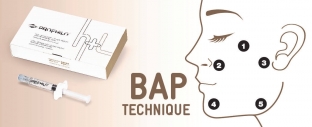 The technique involves the introduction of the drug at
The technique involves the introduction of the drug at
(5 BEP) on each side of the face. Injections are carried out in the malar and submalar zone: from the beginning of the nasolabial fold, in the area of the tragus and marionette wrinkles. This allows us to achieve incredible results not only in the area prone to atrophy of the skin caused by age-related changes, but also to completely improve the overall condition of the face.
Technique 5 BEP is applicable exclusively with the use of PROFHILO due to its unique properties.To ; ; ; After
To ; ; ; After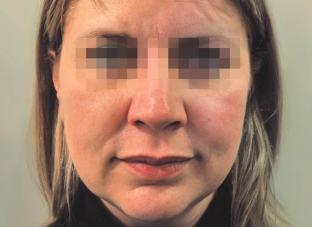
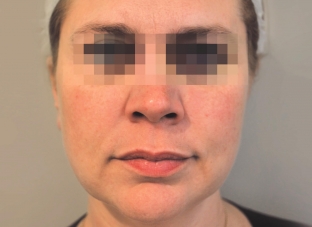
Preparation of tissues for aggressive damage, the purpose of which is to reduce the risk of pathological inflammation and prevent an excessive immune response – is an important component of a successful result of plastic surgery and, as a result, patient satisfaction.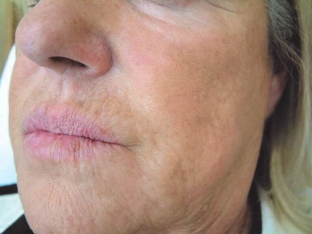
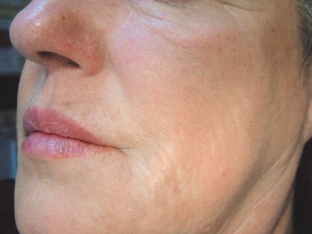 Therefore, a multidisciplinary approach, in particular, the combination of dermatology and plastic surgery, increases the degree of efficiency of the work of specialists in both branches of medicine.
Therefore, a multidisciplinary approach, in particular, the combination of dermatology and plastic surgery, increases the degree of efficiency of the work of specialists in both branches of medicine.






